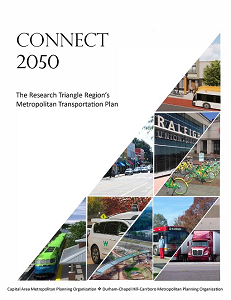2050 Metropolitan Transportation Plan
The Capital Area and the Durham Chapel-Hill Carrboro MPOs worked collaboratively to develop the 2050 Metropolitan Transportation Plan (MTP) for the Triangle region. The MTP is the long-range plan for transportation improvements across the region. It includes roadway, transit, rail, bicycle, pedestrian and other transportation projects for the next 30 years.
2050 MTP Roadway Projects List - Approved - PDF
2050 MTP Interactive Map for Roads, Transit, Bike/Ped
2050 MTP Direct GIS Data Download
In February of 2022, the Executive Board approved the compiled 2050 Metropolitan Transportation Plan which includes the Air Quality Conformity Determination Report, the report document that describes the MTP elements and development process, and the Triangle Regional Model for use in future MPO planning activities. Prior to the final adoption, in December of 2021, the Executive Board approved the 2050 Metropolitan Transportation Plan projects and programs as depicted in the projects lists and interactive maps linked above. The projects and programs make up the bulk of any MTP. More about the MTP Development Process...
Amendment #1
The Executive Board approved Amendment #1 to the 2050 MTP Roadways Project List on August 16, 2023.
2050 MTP - Full Report:
- 2050 MTP - Full Plan Report with Appendices - adopted by the Executive Board on February 16, 2022
2050 MTP Final Report - Individual Chapters
- Table of Contents and Chapter 1 (Executive Summary) (en Español)
- Chapter 2 (What is the Plan?)
- Chapter 3 (About Our Home)
- Chapter 4 (Our Vision)
- Chapter 5 (How We Developed Our Plan)
- Chapter 6 (Analyzing Our Choices)
- Chapter 7 (Our MTP: What We Intend to Do)
- Chapter 8 (Our Financial Plan)
- Chapter 9 (Critical Factors & Emphasis Areas
- Chapter 10 (Post 2050 - CTP Projects)
Appendices
- All Appendices
- Appendix 1 (Community Engagement)
- Appendix 2 (List of Roadway Projects)
- Appendix 3 (List of Transit Projects)
- Appendix 4 (Active Transportation)
- Appendix 5 (Technology Resources)
- Appendix 6 (Joint MPO Policy Priorities)
- Appendix 7 (Air Quality)
- Appendix 8 (MTP Draft Review Comments)
- Appendix 9 (Acronyms)
- Appendix 10 (Growth Maps and MOEs)
- Appendix 11 (Financial Plan Details)
- Appendix 12 (Maps - Enviro. Justice & Critical Resources)
- Appendix 13 (Federal Transportation Performance Measures)
Air Quality Conformity Determination Report - approved by the Executive Board on February 16, 2022
Triangle Regional Model Background Info
Background on Fiscal Constraint
Federal regulations require the 2050 MTP to have a financial plan. This requirement means that the cost of the roadway, transit and other transportation facilities and services must be covered by state, federal, local, private and other transportation revenues that can be reasonably expected to be available. Once final, the MTP's Financial Plan will provide a comparison of expected revenues and costs from 2020 through 2050 – the 30-year period of this plan.
The 2050 MTP divides projects into three time periods:
- Near-term: through 2030;
- Mid-term: 2031 to 2040; and
- Long-term: 2041 to 2050.
These periods are used not only as a matter of good planning practice that more evenly matches and distributes the total costs and revenues over the 30-year planning period, but also so we can analyze the impacts of our investments against air quality benchmarks. The current transportation funding programs will not produce enough revenue to finance the multimodal transportation needs in the Triangle. Therefore, the 2050 MTP will be based on the assumption of certain additional/new revenue sources to close this funding gap. There must be a reasonable expectation to realize these new revenue sources, such as basing it on the many local and statewide commissions that have studied transportation financing and recommended new funding sources. It is important to note the following background information on the Additional/New Revenue Sources proposed in the 2050 MTP:
- Many of these new revenue options would require legislation from the North Carolina General Assembly and/or the U.S. Congress. The MPOs are not empowered to invoke these tax and revenue program changes.
- The 2050 MTP envisions a level of effort to increase revenue for roadways, transit, and bicycle/pedestrian investments but the exact type and mechanism for increasing these revenues, e.g., sales tax, property tax, VMT fees, is not a certainty.
Learn more about the entire 2050 development process, including the foundational work that took place throughout 2020 and 2021 (setting Goals & Objectives, developing Socio-Economic Guide totals, Analyzing Alternative Future Scenarios).

